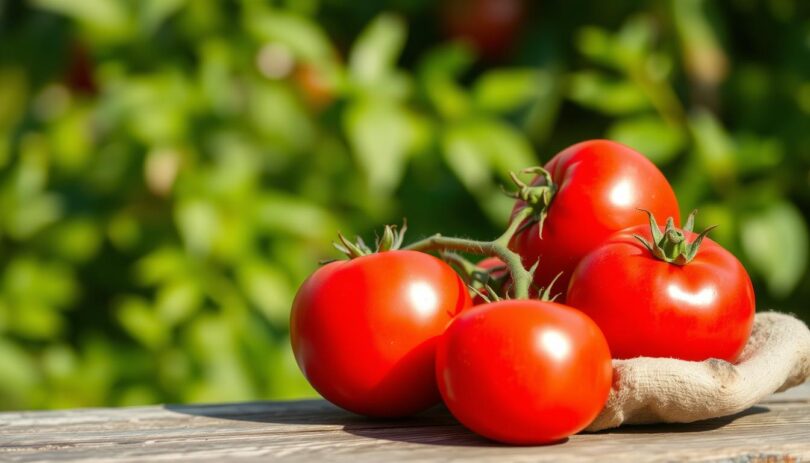Sharing snacks with furry companions often feels natural. Many pet owners wonder about offering fresh produce like juicy red tomatoes. While these fruits can add variety to a pet’s diet, understanding their safety is crucial.
Ripe tomatoes are generally non-toxic for canines when served in moderation. However, green tomatoes or stems and leaves contain solanine, a harmful compound. Veterinarians emphasize removing these parts to avoid digestive upset or tomatine poisoning.
Balancing nutrition and risk requires careful portion control. A small slice occasionally offers vitamins A and C. Yet overfeeding may lead to stomach issues. Always supervise pets when introducing new foods.
This guide explores safe serving practices, health benefits, and potential hazards. Learn how to prepare this treat properly and recognize warning signs of adverse reactions. Knowledge empowers pet parents to make confident choices for their animal’s well-being.
Exploring Ripe Tomatoes: Benefits and Precautions for Dogs
Ripe tomatoes offer a blend of nutrients that can enhance a pet’s well-being when prepared correctly. These vibrant fruits are packed with vitamins and minerals, making them a low-calorie addition to meals. However, proper handling ensures safety while maximizing their nutritional value.
Nutritional Advantages of Ripe Tomatoes
Rich in vitamins A, C, and K, ripe tomatoes support vision, skin health, and blood clotting. Antioxidants like lycopene help combat inflammation, while potassium aids muscle function. Their fiber content promotes smooth digestion, reducing constipation risks in pets.
Folate and beta-carotene in these fruits also contribute to cellular repair and immune strength. Veterinarians note that small portions can address nutrient gaps without overwhelming a pet’s diet. Always prioritize fresh, fully ripened options to avoid harmful compounds.
Proper Serving Sizes and Preparation Methods
Remove stems and leaves thoroughly, as they contain traces of solanine. Dice the flesh into pea-sized pieces to prevent choking. Start with a teaspoon-sized portion for smaller breeds, adjusting based on weight.
Introduce this food gradually, monitoring for vomiting or diarrhea. Cooking isn’t necessary, but washing thoroughly removes pesticides. Pairing tomatoes with lean proteins creates balanced, vet-approved snacks.
Can Dogs Eat Tomato
Pet owners often question which human foods align with their companion’s dietary needs. While ripe, red varieties pose minimal risks when handled properly, unripe or improperly prepared options require caution.
Understanding Safe Consumption
Fully ripened tomatoes lack significant levels of harmful compounds. Always remove stems, leaves, and green portions before offering the flesh. Start with a bite-sized piece to test tolerance.
Portion size matters—a teaspoon per 10 pounds of body weight prevents digestive upset. Mixing chopped flesh with regular meals adds variety without disrupting nutritional balance. Watch for signs like itching or lethargy during initial trials.
Tomatine: What It Is and Why to Avoid It
This natural toxin appears in green tomatoes and leafy parts of the plant. Even small quantities may cause vomiting, drooling, or irregular heartbeats in sensitive animals.
Cooking doesn’t neutralize tomatine, making prevention critical. Store garden-grown plants out of reach, and inspect store-bought options for unripe spots. Immediate veterinary care becomes essential if exposure occurs.
Identifying Tomato-Related Health Risks in Dogs
While many fruits are safe for pets, certain parts of tomato plants pose hidden dangers. Green tomatoes, leaves, and stems contain tomatine, a natural toxin that can harm animals. Understanding these risks helps owners protect their companions.
Recognizing Symptoms of Tomatine Poisoning
Early signs of toxicity include excessive drooling and gastrointestinal distress. Vomiting or diarrhea often appears within hours of ingestion. Pets may show lethargy or refuse food due to stomach discomfort.
Severe cases involve muscle weakness and loss of coordination. Watch for trembling or irregular breathing patterns. Small breeds and puppies face higher risks due to their size.
When to Call Your Veterinarian
Contact a vet immediately if your pet consumes green tomatoes or plant parts. Provide details about the quantity eaten and timing of symptoms. Professionals may perform blood tests or administer activated charcoal.
Delayed treatment can worsen conditions like dehydration or heart irregularities. For other food safety questions, explore our guide on safe fruits for pets. Always keep emergency vet numbers accessible.
Safe Practices for Feeding Tomatoes to Your Pooch
Introducing new foods requires careful planning to ensure safety. While ripe tomato flesh can be a nutritious snack, strategic handling minimizes risks. Follow these guidelines to balance variety with well-being.
Guidelines for Moderation and Supervision
Portion control is critical. Offer no more than one teaspoon per 10 pounds of body weight weekly. Always observe reactions after initial servings—watch for digestive changes or skin irritation.
Supervise pets near garden areas with tomato plants. Curiosity might lead them to nibble on fallen leaves or unripe fruits. Redirect attention with approved chew toys during outdoor activities.
Preventing Access to Hazardous Tomato Plant Parts
Green tomatoes, stems, and leaves contain harmful compounds. Secure indoor plants on high shelves and fence outdoor gardens. Regularly check yards for fallen plant debris.
When preparing snacks, remove all stems and green parts thoroughly. Even small amounts of these components can cause discomfort. Store fresh produce in pet-proof containers immediately after use.
Storing and Serving Tips for a Healthy Diet
Wash tomatoes thoroughly to eliminate pesticides. Dice flesh into pea-sized pieces to prevent choking. Mix with regular meals instead of offering alone.
Freeze small amounts for a cooling summer treat. Avoid seasoned or cooked varieties containing garlic or onions. Consult your vet before making dietary changes for pets with health conditions.
Final Reflections on Tomato Treats for Your Pet
Incorporating human foods into a pet’s diet demands thoughtful choices. Ripe tomatoes, when prepared safely, offer vitamins and antioxidants that support overall health. Removing stems, leaves, and unripe portions ensures these snacks remain a low-risk option for occasional enjoyment.
Moderation remains key. Small portions prevent digestive issues while allowing pets to benefit from nutrients like lycopene and vitamin C. Pairing diced tomato flesh with regular meals adds variety without disrupting nutritional balance.
Owners should always consult their veterinarian before introducing new items. This step helps address individual sensitivities and aligns treats with specific dietary needs. Supervision during feeding minimizes risks of accidental ingestion of harmful plant parts.
Balancing potential benefits with caution empowers pet parents to make confident decisions. Proper preparation and portion control transform tomatoes into a wholesome supplement. Informed choices foster happier, healthier lives for both animals and their people.
FAQ
Are green tomatoes harmful to pets?
Unripe tomatoes contain higher levels of tomatine, a compound that can cause digestive upset. Always remove stems and leaves, and avoid feeding green varieties to minimize risks.
How much tomato is safe for a 20-pound dog?
A few small pieces of ripe fruit (about 1-2 tablespoons) occasionally are generally safe. Monitor for reactions like vomiting, and consult your vet for portion guidance based on your pet’s health.
What should I do if my pet eats tomato plant leaves?
Contact your veterinarian immediately if they consume leaves or stems. These parts contain concentrated tomatine, which may lead to drooling, lethargy, or gastrointestinal distress requiring professional care.










Leave a Comment